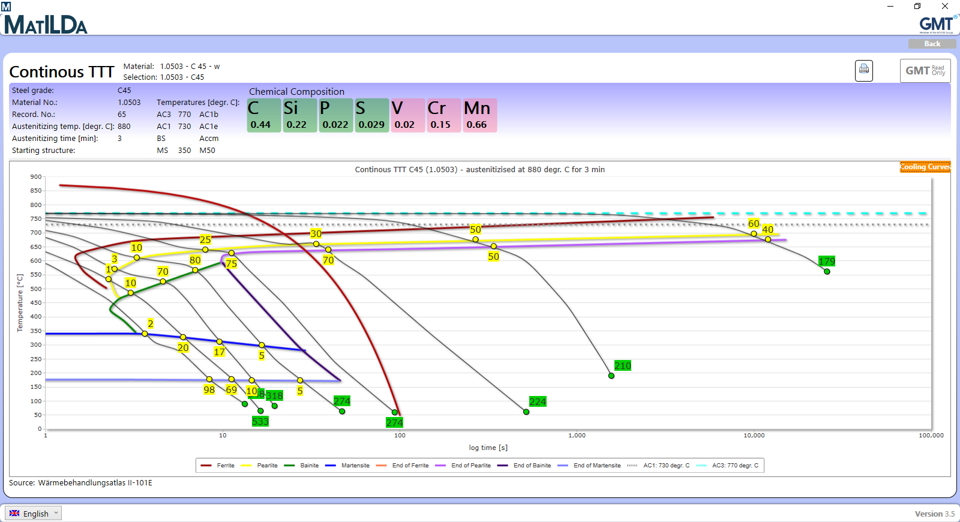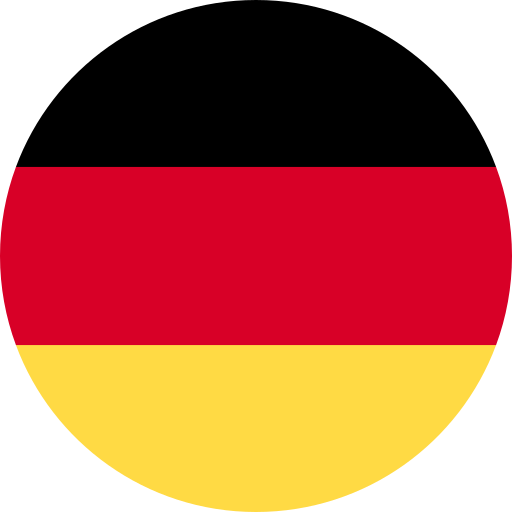Simulate phase transformation using the CCT database and neuronal networks
Simulating phase transformation is a key element of material simulation. Various CCT diagrams help to determine microstructure fractions and hardness values. By using neuronal networks, phase transformation for individual steel alloys and austenitizing conditions can be simulated even more precisely.
The CCT database in MatILDa®
In MatILDa®’s CCT database, experimentally recorded and standardized CCT and TTT diagrams are available in a digital library for a large number of steel grades:
• continuous CCT diagrams,
• forming CCT diagrams,
• welding CCT diagrams,
• isothermal CCT diagrams and
• TTT diagrams.
• forming CCT diagrams,
• welding CCT diagrams,
• isothermal CCT diagrams and
• TTT diagrams.

Information on the austenitizing temperatures and the austenitizing time as well as the exact chemical analysis can be displayed in the CCT database. In addition, the important temperatures such as Ac3, Ac1, bainite start temperature BS und martensite start temperature MS can be displayed in the CCT data base. By adding individual cooling curves, the user can understand the phase transformation shaped by the conditions in the industrial process. In the continuous CCT diagrams, the phase fractions and the hardness values can be found in addition to the starting temperatures for martensite, bainite, ferrite and pearlite formation.
The database’s open interface permits users to import additional digitalized CCT / TTT diagrams and to implement this information in further calculations involving FEM simulation software.
The database’s open interface permits users to import additional digitalized CCT / TTT diagrams and to implement this information in further calculations involving FEM simulation software.
Simulating phase transformation using neuronal networks
A disadvantage of individual CCT and TTT diagrams is that the microstructure fractions and hardness values are only valid for the specific parameters (concrete chemical analysis, austenitizing temperature and time) from the experiment. Thus, MatILDa®’s competence is strengthened by the integration of neuronal networks developed by GMT – referred to in the CCT database as calculated TTT diagram. A major advantage is the validity of a neuronal network for a predefined range of austenitizing temperatures as well as chemical analyses, which can be selected by means of sliders. The use of neuronal networks allows users to make predictions regarding microstructure fractions, ferrite grain size, pearlite lamellar spacing and mechanical product properties.

MatILDa® exhibits another special feature: For detailed examination, phase formations are displayed in the form of logarithmic t85 diagrams. User-friendly controls allow quick adjustments of values and application of changes in microstructure portions.
Please also read our publications about the phase transformation:
Utilizing AI in Materials Simulation: Modeling Phase Transformation in Forming Processes and Heat Treatments. Steel Innovation, 26.10.2023, Köln, Deutschland. (PDF, 1 MB)
AI-Supported Material Simulation of Forming Processes. AISTech, 09.05.2023, Detroit, USA. (PDF, 1,5 MB)
AI-Supported Material Simulation of Forming Processes. AISTech, 09.05.2023, Detroit, USA. (PDF, 1,5 MB)
Ask for more details about our CCT database and neuronal networks!
✔ We have 20+ years of expertise
✔ We successfully advise and support customers from a wide range of industries
✔ Save time & costs through reliable CCT and TTT diagrams and neuronal networks
✔ Your inquiry is free-of-charge & non-binding
✔ We successfully advise and support customers from a wide range of industries
✔ Save time & costs through reliable CCT and TTT diagrams and neuronal networks
✔ Your inquiry is free-of-charge & non-binding
Interfaces & Functionalities
Convenient data exchange via standard interfaces, e.g. with QForm UK, simufact and AutoForm
MatILDa®
The materials database for realistic FEM simulation

